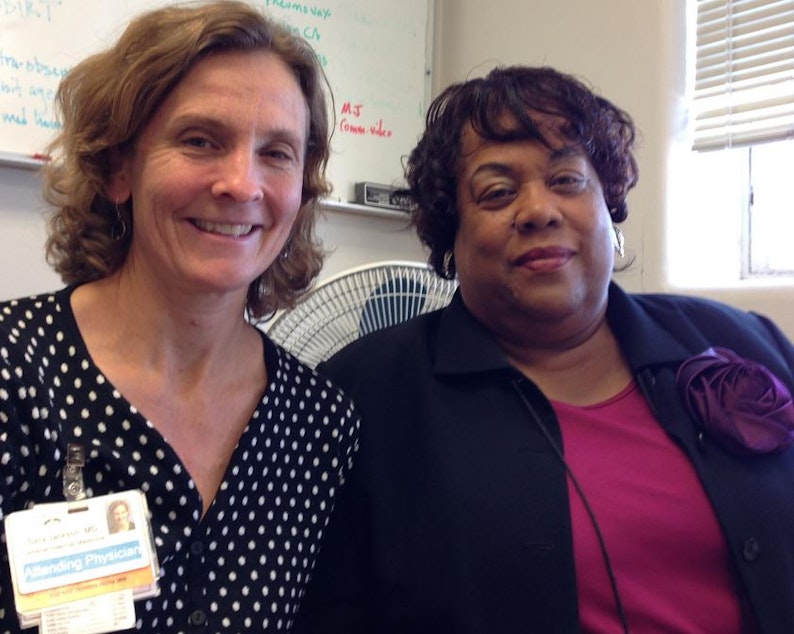When Doctors Invite Patients To Read Their Notes

Do you wonder what your doctor scribbles in the chart during your visit?
Patients at Harborview Medical Center got to read their medical records, including their doctors’ detailed notes. For some, that access prompted them to become more involved in their health care.
Linda Johnson, 67, had been relatively healthy all her adult life. She didn’t think too much about her health. Then two things happened that changed her outlook.
In 2008, she fell unconscious in her office. When she came to, there were paramedics trying to resuscitate her. She has since recovered from that incident, but looking back, that jolted her. “I realized it was time to focus on my health,” she says.
That year, Johnson retired from her job in real estate development so she could better manage her health. “The only thing I knew to do was to cut down the stress in my life, which was my job,” says Johnson, “and go see my doctor, take my medications. That’s all I knew.”
Two years later she discovered a new tool to help her do more than that. Johnson was part of a national study where she got access to her medical records. Not just the summary, but her doctor’s detailed notes, too. She remembers the first time she read what the doctor wrote about her. “I marveled at how well she captured everything because she doesn’t take notes while we’re talking,” she says.
Johnson’s doctors at Harborview Medical Center were part of a year-long experiment called Open Notes. The study wanted to gauge whether opening up clinic notes would encourage patients to become more involved in their care, and whether it would improve communication with their doctors.
Johnson says those notes gave her a better grasp of her health. It also changed the way she relates to her doctor. “I’m not an appointment to my doctor,” she says, “I’m a patient.”
Sitting across the table from her is Sara Jackson, Johnson’s primary care doctor.
“We have dialogue with each other, to her dismay probably,” Johnson says. “And sometimes I’ll come up with some strange things, but I know we’re going to have a conversation, and I’m going to feel comfortable that when I leave that I’ve got all my questions answered.”
Patients may have embraced Open Notes. But Jackson said her colleagues had concerns initially. “A lot of people were concerned that it would be confusing to patients or cause worry for them to see notes, and it would take time to write notes.”
Traditionally these notes are for doctors — to help them keep track of what’s discussed during an office visit. It’s also a way to communicate with other doctors who might be involved in the patient’s care. So not surprisingly, they’re filled with medical shorthand. A patient reading the notes might be taken aback with some abbreviations.
Take shortness of breath. “That’s one of the common ones — SOB,” says Jackson. “And now that more people are opening the notes, those are the ones that we try to encourage people to rethink.”
And the concern about more work? Turns out, it wasn’t an issue.
“Writing my notes takes me a lot of time anyway, and it didn’t take more time than it does,” Jackson says. “I think in primary care, that process just takes a lot longer and I don’t think anybody noticed an appreciable increase in that.”
Overall, the feedback toward open notes was positive. Most of the patients who took part said they felt more in control of their care. Those who were on medication were motivated to keep it up.
It was only a decade ago when doctors and hospitals transitioned to electronic health records.
Now the next frontier is sharing those records with patients.
Last October UW Medicine extended Open Notes to its patients. Nationwide, more than 5 million patients now have access to their records.
Jackson says electronic medical records are still in their infancy. She hopes that as the system evolves it will become more user-friendly for both patients and doctors.
For Johnson, Open Notes has helped keep her children informed of what’s going on in her health. Like last year when she had another medical scare that required surgery. Her daughter, who lives in Baltimore, was able to keep track. Eventually, she met the author of those notes in person.
“My daughter’s pleased that she’s not an older physician,” says Johnson, “so we know she’s going to be around for a while!”
Johnson isn’t a big online user -- she says doesn’t use Facebook or social media, but she does do Open Notes. After all, it’s part of her medicine.

